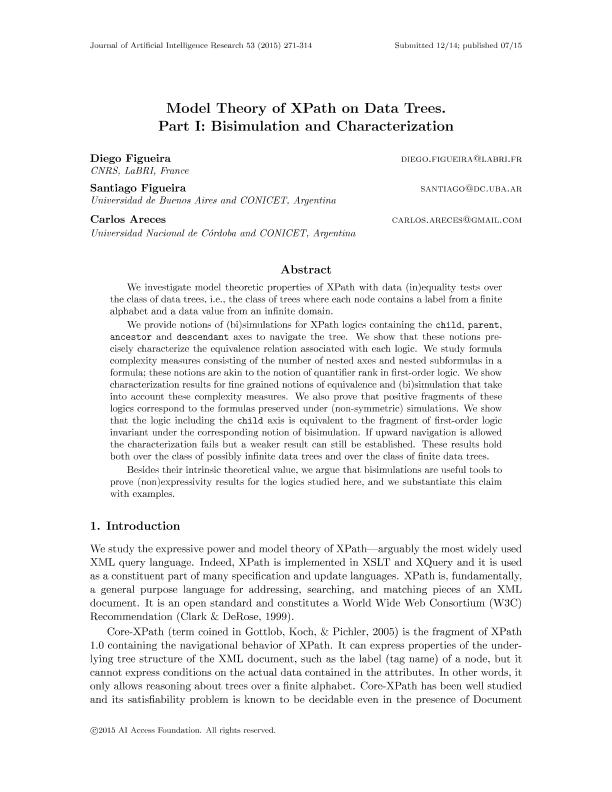Mostrar el registro sencillo del ítem
dc.contributor.author
Figueira, Diego

dc.contributor.author
Figueira, Santiago

dc.contributor.author
Areces, Carlos Eduardo

dc.date.available
2018-05-07T19:07:40Z
dc.date.issued
2015-07
dc.identifier.citation
Figueira, Diego; Figueira, Santiago; Areces, Carlos Eduardo; Model Theory of XPath on Data Trees: Part I: Bisimulation and Characterization; AI Access Foundation; Journal of Artificial Intelligence Research; 53; 7-2015; 271-314
dc.identifier.issn
1076-9757
dc.identifier.uri
http://hdl.handle.net/11336/44354
dc.description.abstract
We investigate model theoretic properties of XPath with data (in)equality tests over the class of data trees, i.e., the class of trees where each node contains a label from a finite alphabet and a data value from an infinite domain.We provide notions of (bi)simulations for XPath logics containing the child, descendant, parent and ancestor axes to navigate the tree. We show that these notions precisely characterize the equivalence relation associated with each logic. We study formula complexity measures consisting of the number of nested axes and nested subformulas in a formula; these notions are akin to the notion of quantifier rank in first-order logic. We show char- acterization results for fine grained notions of equivalence and (bi)simulation that take into account these complexity measures. We also prove that positive fragments of these logics correspond to the formulas preserved under (non-symmetric) simulations. We show that the logic including the child axis is equivalent to the fragment of first-order logic invariant under the corresponding notion of bisimulation. If upward navigation is allowed the characterization fails but a weaker result can still be established. These results hold both over the class of possibly infinite data trees and over the class of finite data trees.Besides their intrinsic theoretical value, we argue that bisimulations are useful tools to prove (non)expressivity results for the logics studied here, and we substantiate this claim with examples.
dc.format
application/pdf
dc.language.iso
eng
dc.publisher
AI Access Foundation

dc.rights
info:eu-repo/semantics/openAccess
dc.rights.uri
https://creativecommons.org/licenses/by-nc-sa/2.5/ar/
dc.subject
Xpath
dc.subject
Bisimulación
dc.subject
Caracterización
dc.subject
Expresividad
dc.subject.classification
Ciencias de la Computación

dc.subject.classification
Ciencias de la Computación e Información

dc.subject.classification
CIENCIAS NATURALES Y EXACTAS

dc.title
Model Theory of XPath on Data Trees: Part I: Bisimulation and Characterization
dc.type
info:eu-repo/semantics/article
dc.type
info:ar-repo/semantics/artículo
dc.type
info:eu-repo/semantics/publishedVersion
dc.date.updated
2018-04-16T14:55:55Z
dc.identifier.eissn
1943-5037
dc.journal.volume
53
dc.journal.pagination
271-314
dc.journal.pais
Estados Unidos

dc.description.fil
Fil: Figueira, Diego. Centre National de la Recherche Scientifique; Francia
dc.description.fil
Fil: Figueira, Santiago. Consejo Nacional de Investigaciones Científicas y Técnicas. Oficina de Coordinación Administrativa Ciudad Universitaria; Argentina. Universidad de Buenos Aires. Facultad de Ciencias Exactas y Naturales. Departamento de Computación; Argentina
dc.description.fil
Fil: Areces, Carlos Eduardo. Consejo Nacional de Investigaciones Científicas y Técnicas. Oficina de Coordinación Administrativa Ciudad Universitaria; Argentina. Universidad Nacional de Córdoba. Facultad de Matemática, Astronomía y Física; Argentina
dc.journal.title
Journal of Artificial Intelligence Research

dc.relation.alternativeid
info:eu-repo/semantics/altIdentifier/url/https://jair.org/index.php/jair/article/view/10945
dc.relation.alternativeid
info:eu-repo/semantics/altIdentifier/doi/https://doi.org/10.1613/jair.4658
Archivos asociados
